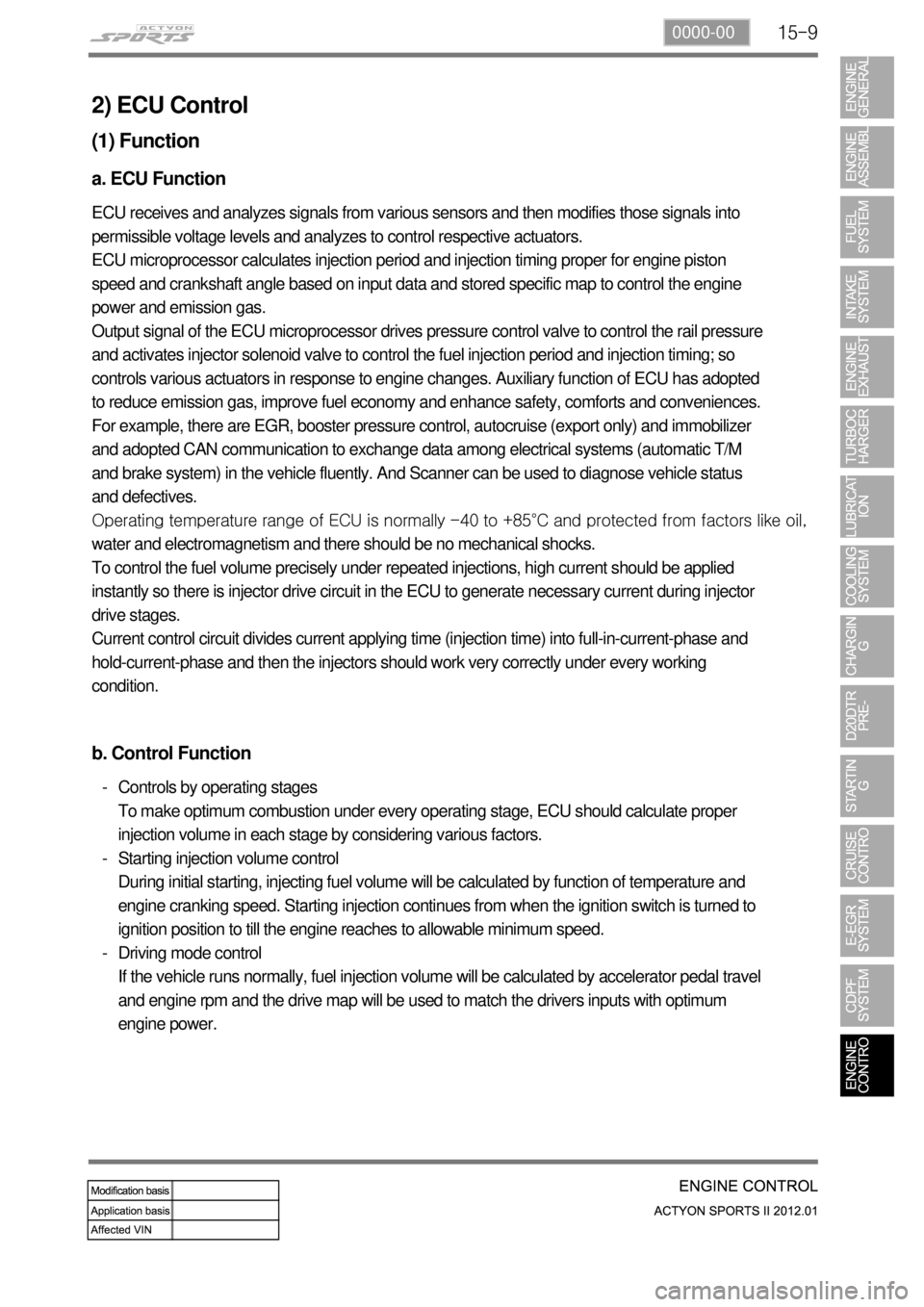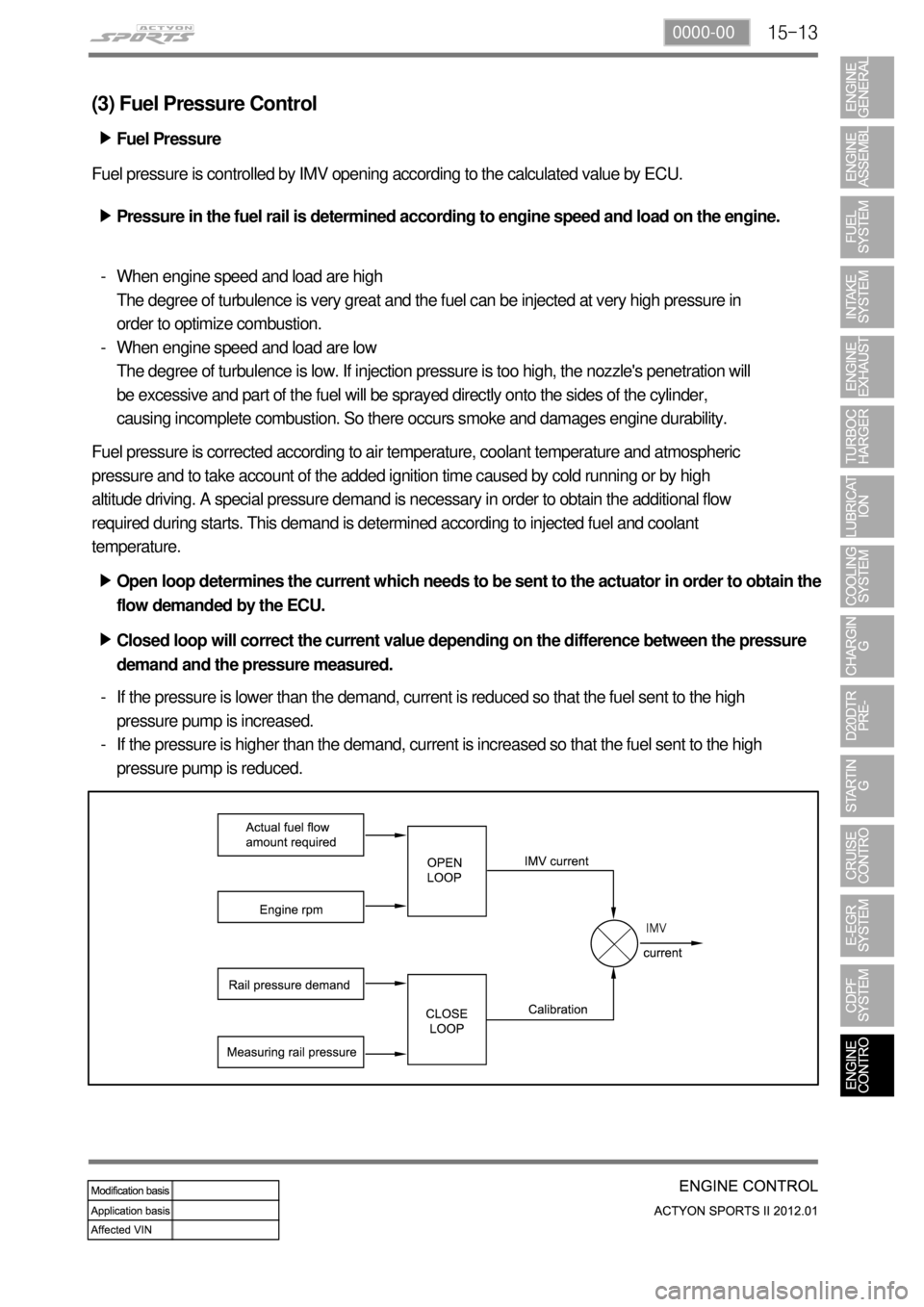Page 302 of 828
14-14
2) Collecting PM of DPF
There is a filter installed in the DPF and the PM filtered by this filter is burned (regeneration) when
the temperature of exhaust gas is increased due to post-injection. The filter has a honeycomb-
like structure to capture the particulate matter and the inlet and outlet of each channel are closed
alternatively. Once the exhaust gas enters to the inlet of a channel, it is released from the outlet of
the adjacent channel through the porous wall because of the closed outlet of the first channel,
and the PM is collected in the first channel.
[Collecting PM of CDPF]
Normally, when the driving distance becomes approx. 600 to 1,200 km, enough amount of
soot to be burned is filtered and accumulated in the CDPF. The ECU increases the amount of
fuel post-injection to increase the temperature of the exhaust gas up to 600°C, so that the
soot is burned. The soot is burned for 15 to 20 minutes (may differ by conditions).
Page 303 of 828
14-152412-02
3) PM Regeneration of DPF
The differential pressure sensor installed in the DPF measures the pressure values of inlet and
outlet of CDPF. And the amount of the PM collected in the filter is calculated based on the exhaust
temperature, intake air mass flow, booster pressure, etc.
The regeneration is started when the amount of the collected PM is 28 g or more.
<007b008f008c0047006c006a007c0047008a00960094009400880095008b009a004700970096009a009b0054009000950091008c008a009b0090009600950047009b0096004700900095008a0099008c0088009a008c0047009b008f008c0047009b008c00
940097008c00990088009b009c0099008c00470096008d0047>CDPF to 600℃.
When the amount of the collected PM is not enough: The DPF works as a filter. 1.
When enough amount of PM is collected: The ECU commands post-injection and increase the
exhaust gas temperature to start regeneration. 2.
Page 308 of 828
15-50000-00
Fuel rail pressure
sensorEGR valveFuel temperature
sensor
Electric throttle bodyKnock sensor
(2 ea)
Coolant temperature
sensor
T-MAP sensorD20DTR ECU
E-VGT actuator
Water sensorGCU (Preglow control
unit)
E-EGR bypass valve
Page 309 of 828
15-6
2. SYSTEM OPERATION
1) Input/Output of ECU
(1) ECU Block diagram
Page 310 of 828
15-70000-00
Fuel rail pressure
sensor
(2) Components for ECU Input
CAN
- ABS & ESP
- GCU
- Instrument
cluster
- TCUSwirl valve position
sensor
Differential
pressure sensorE-EGR valve
position sensorCamshaft position
sensorCoolant
temperature senso
r
Exhaust gas
temperature senso
r
HFM sensorOxygen sensorT-MAP sensor
Crankshaft position
sensor
Accelerator pedal
sensorThrottle position
sensorKnock sensor
-Auto cruise switch
- Rear right wheel
speed (without ABS)
- Refrigerant pressure
sensor
- Clutch pedal signal
- Blower switch signal
- Brake pedal signal
Water sensor
Page 311 of 828
15-8
(3) Components for ECU Output
CAN
E-EGR cooler
bypass valve
- Instrument cluster
- TCU
- Self diagnosis
PTC heaterCooling fan
E-EGR valve
Variable swirl valveE-VGT actuatorIMV valve
A/C compressorInjectorThrottle position
sensor
- Glow plug unit
- ABS & ESP unit
- GCU
Page 312 of 828

15-90000-00
2) ECU Control
(1) Function
a. ECU Function
ECU receives and analyzes signals from various sensors and then modifies those signals into
permissible voltage levels and analyzes to control respective actuators.
ECU microprocessor calculates injection period and injection timing proper for engine piston
speed and crankshaft angle based on input data and stored specific map to control the engine
power and emission gas.
Output signal of the ECU microprocessor drives pressure control valve to control the rail pressure
and activates injector solenoid valve to control the fuel injection period and injection timing; so
controls various actuators in response to engine changes. Auxiliary function of ECU has adopted
to reduce emission gas, improve fuel economy and enhance safety, comforts and conveniences.
For example, there are EGR, booster pressure control, autocruise (export only) and immobilizer
and adopted CAN communication to exchange data among electrical systems (automatic T/M
and brake system) in the vehicle fluently. And Scanner can be used to diagnose vehicle status
and defectives.
<00760097008c00990088009b00900095008e0047009b008c00940097008c00990088009b009c0099008c0047009900880095008e008c00470096008d0047006c006a007c00470090009a0047009500960099009400880093009300a000470054005b005700
47009b009600470052005f005c00b6006a004700880095008b> protected from factors like oil,
water and electromagnetism and there should be no mechanical shocks.
To control the fuel volume precisely under repeated injections, high current should be applied
instantly so there is injector drive circuit in the ECU to generate necessary current during injector
drive stages.
Current control circuit divides current applying time (injection time) into full-in-current-phase and
hold-current-phase and then the injectors should work very correctly under every working
condition.
b. Control Function
Controls by operating stages
To make optimum combustion under every operating stage, ECU should calculate proper
injection volume in each stage by considering various factors.
Starting injection volume control
During initial starting, injecting fuel volume will be calculated by function of temperature and
engine cranking speed. Starting injection continues from when the ignition switch is turned to
ignition position to till the engine reaches to allowable minimum speed.
Driving mode control
If the vehicle runs normally, fuel injection volume will be calculated by accelerator pedal travel
and engine rpm and the drive map will be used to match the drivers inputs with optimum
engine power. -
-
-
Page 316 of 828

15-130000-00
(3) Fuel Pressure Control
Fuel pressure is controlled by IMV opening according to the calculated value by ECU.
Pressure in the fuel rail is determined according to engine speed and load on the engine. ▶
When engine speed and load are high
The degree of turbulence is very great and the fuel can be injected at very high pressure in
order to optimize combustion.
When engine speed and load are low
The degree of turbulence is low. If injection pressure is too high, the nozzle's penetration will
be excessive and part of the fuel will be sprayed directly onto the sides of the cylinder,
causing incomplete combustion. So there occurs smoke and damages engine durability. -
-
Fuel pressure is corrected according to air temperature, coolant temperature and atmospheric
pressure and to take account of the added ignition time caused by cold running or by high
altitude driving. A special pressure demand is necessary in order to obtain the additional flow
required during starts. This demand is determined according to injected fuel and coolant
temperature.
Open loop determines the current which needs to be sent to the actuator in order to obtain the
flow demanded by the ECU. ▶
Closed loop will correct the current value depending on the difference between the pressure
demand and the pressure measured. ▶
If the pressure is lower than the demand, current is reduced so that the fuel sent to the high
pressure pump is increased.
If the pressure is higher than the demand, current is increased so that the fuel sent to the high
pressure pump is reduced. -
-Fuel Pressure ▶